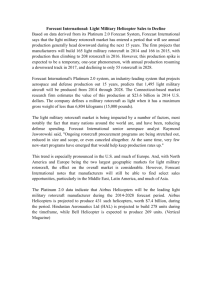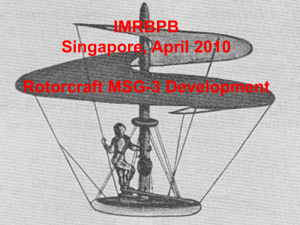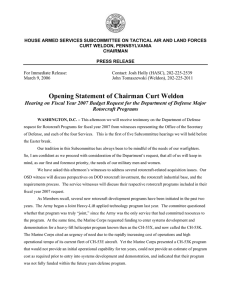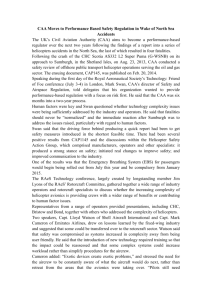FOR OFFICIAL USE ONLY UNTIL RELEASED BY THE HOUSE COMMITTEE
advertisement
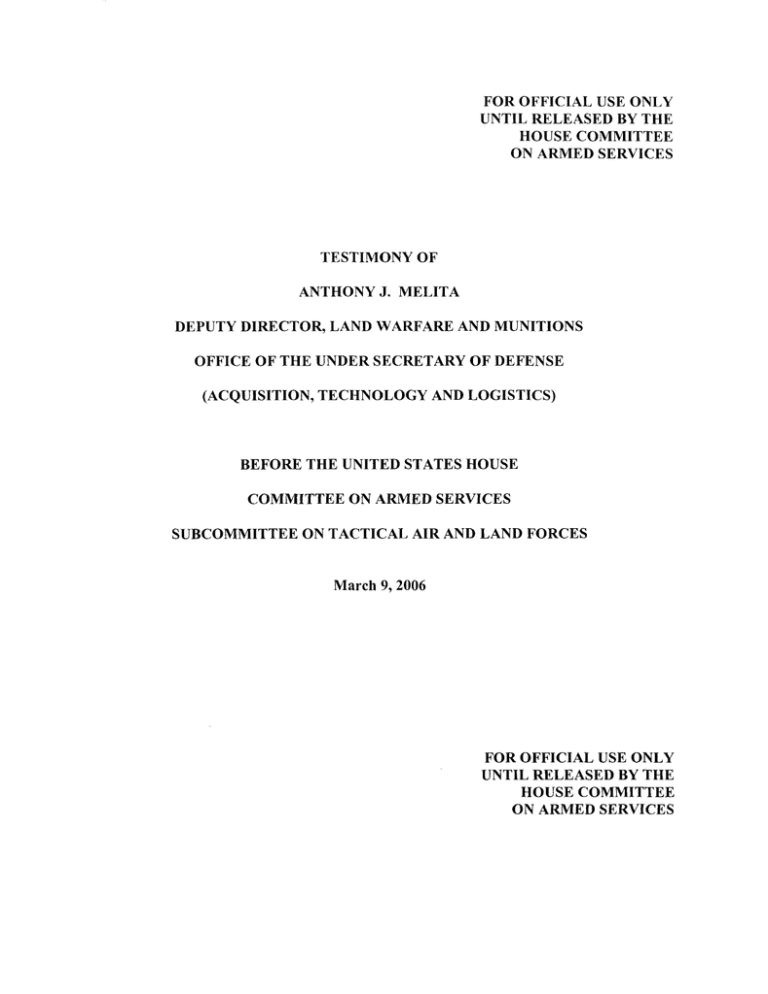
FOR OFFICIAL USE ONLY UNTIL RELEASED BY THE HOUSE COMMITTEE ON ARMED SERVICES TESTIMONY OF ANTHONY J. MELITA DEPUTY DIRECTOR, LAND WARFARE AND MUNITIONS OFFICE OF THE UNDER SECRETARY OF DEFENSE (ACQUISITION, TECHNOLOGY AND LOGISTICS) BEFORE THE UNITED STATES HOUSE COMMITTEE ON ARMED SERVICES SUBCOMMITTEE ON TACTICAL AIR AND LAND FORCES March 9,2006 FOR OFFICIAL USE ONLY UNTIL RELEASED BY THE HOUSE COMMITTEE ON ARMED SERVICES INTRODUCTION Good afternoon Mr. Chairman, Mr. Abercrombie, and Members of the Committee. Thank you for the opportunity to express the Department's views on the progress we have made in our rotorcraft programs. This committee has consistently provided direction and support to efforts in developing and fielding the rotorcraft our war fighters need and deserve. Many of our helicopter-related successes we owe in large part to the unwavering support this committee has provided. We thank you for that. THE U.S. ROTORCRAFT INDUSTRIAL BASE The Deputy Under Secretary of Defense for Industrial Policy (DUSD(IP)) completed in July 2004 a study of the U.S rotorcraft industrial base using a capabilities-based framework. The report, titled "The Vertical Lift Industrial Base: Outlook 2004-2014," was coordinated with industry. (The complete report can be accessed at: hl,t_l~:II_lk~\v.acq .osdxnd/ig.) DUSD(1P) reported positive findings consistent with previous studies that the U.S. industrial base is quite capable of meeting the Department's planned programs in terms of facilities, manpower, and corporate strength. The report characterized the vertical lift industrial base as "being shaped by government and industry responses to the Nunn-McCurdy breaches of 2001 and the unintended consequences of Department-endorsed teaming arrangements that resulted in an interlocked industrial base that restricted Department and industry flexibility." Over many years, the Department opted to maintain its vertical lift capability with a "remanufacture strategy" rather than develop new aircraft. In recent years, Government funded priorities for advanced rotorcraft technology shifted from manned to unmanned. The report continued by stating that "this industry will be shaped by the operational experiences and associated refurbishment requirements resulting from the Global War on Terrorism." In fact, the Department has since modified the UH-GOM, CH-47F and UH-1Y programs to new-production rather than remanufacture. A range of operational realities led the Army to restructure its aviation portfolio; the Comanche program was cancelled to fund rapid replacement of aged aircraft. Similarly the performance limitations of the Presidential Helicopters, which originally began service under President Kennedy, led to the VH-71 program Last year, the Marines initiated the H-53 Heavy Lift Replacement program to correct a critical inventory problem. The operational experience of the Services since Operation Enduring Freedom began has resulted in changes that have provided new opportunities for competition, contracts for newer platforms, and changes in the trends in Government investment. The robust competitions for the Armed Reconnaissance Helicopter (ARH), the Light Utility Helicopter (LUH), and the Presidential Replacement Helicopter provide examples of this stimulus to the industry. The Department continues to examine and shape its programs with a view to the greater context in which they fit and by looking at factors such as the readiness of complementary systems. Former Under Secretary Wynne left us with a legacy of robust systems engineering discipline that is having clear and immediate results, and promises to provide long term benefits as well. DEPARTMENT OF DEFENSE INVESTMENT IN ROTORCRAFT At present, the Services have a substantial capability and investment in both manned and unmanned rotorcraft programs and nearly every aircraft-model program in the rotary wing inventory has major activity: The Army AH-64 Apache Program is converting A-models to the D-model configuration, building a limited number of new replacement aircraft, and starting engineering that will result in a Block I11 configuration. CH-47F Chinooks are being remanufactured and built new with a full digital cockpit. The UH-60 Black Hawk program continues to produce L-models at full rate and M-models at low-rate while completing operational testing, and has started engineering efforts for planned capability improvements to use fly-by-wire technology and a digital cockpit common among Army aircraft. The ARH-- the replacement for the venerable OH-58 Kiowa Warrior -- is being developed at a rapid pace; the first test aircraft began flights less than 7 months after contract award. The LUH, which will replace several old models and which will provide a major capability boost to the National Guard and Reserves, is completing a very extensive source selection that will culminate in a program start at the production milestone - a unique acquisition approach for this sector. The Navy is fully committed to producing MH-60 Seahawks in two configurations: the MH-60R for antisubmarine warfare and the MH-60s for other missions. These aircraft upgrade and replace the older SH-60B and -F models. The MH-60s are produced using a common multiyear contract for Army and Navy aircraft. The Marine Corps MV-22 was approved for full production last fall; older CH-46 squadrons are transitioning to the MV-22, the first operational squadron has begun preparing for deployment in FY 2007, and development of the SOCOM CV-22 and the next capability blocks of the MV-22 continues. The H-1 Upgrades program is in low-rate production and is scheduled to begin Operational Evaluation this year. Systems Design and Development for the H-53 model aircraft which will replace the CH-53E fleet has begun. In addition to manned systems, there is extensive activity in multiple unmanned rotorcraft programs. The Department presently has one unmanned rotorcraft production program: Fire Scout. This Vertical Take-Off and Landing (VTOL) tactical unmanned rotorcraft is in development for use on the Navy's Littoral Combat Ship (LCS) and for the Army's Future Combat System (FCS). LCS's Initial Operating Capability is scheduled in FY08 and FCS is scheduled for FY 14. Although not a Department program, the Coast Guard in the Department of Homeland Security is developing and procuring the Eagle Eye unmanned rotorcraft for their Deepwater program. Much like the progress of unmanned fixed wing systems, the Department anticipates a rapid growth in unmanned rotorcraft as a result of significant investment and attributes of unmanned rotorcraft technology. The Defense Advanced Research Projects Agency for example is looking at several emerging rotorcraft technology areas, they include: The X-50 Dragonfly Canard RotorIWing which combines the VTOL capability of a helicopter with the high-subsonic cruise speed of a fixed-wing aircraft. The A-160 Hummingbird is designed to demonstrate the capability for marked improvements in performance (range, endurance, and controllability), as compared to conventional helicopters. This technology is being applied to the Special Operations Forces Long Endurance Demonstrator Advanced Concept Technology Demonstration which demonstrates the unique aspects of the special force's mission. The DP-5X is planned to be an FCS compliant unmanned aircraft. The rotorcraft is modular and will facilitate reconfigurations to include or remove subsystem components. In general terms, the Department-wide activity in rotary wing programs is indicative of the importance the war fighters place on these platforms. We haven't fought a war, evacuated an embassy, or conducted a humanitarian mission since the Korean War without helicopters. The utility of helicopters is so easily recognized, even by the layman, that it's mistaken for a commodity that's always available. While the commodity assumption is flattering from a capability viewpoint, it leads to an incorrect presumption that helicopters are simple, cheap, and as available as a commodity. The technical complexity of rotary wing aircraft is evident in the large parts counts and the fact that helicopters take longer than fixed wing aircraft to develop and produce. Similarly, integrating systems on helicopters is equally or more challenging. Fixed wing aircraft incorporate technology improvements that have not yet transitioned to rotary wing aircraft. For all the right reasons, the Department began investing in fixed wing technology after Viet Nam and has sustained focused investments since. The results are stellar; U.S. airpower is unquestioned. Our investment in rotary wing aircraft has similarly provided a world-class force and the Department has made prudent investments to ensure the warfighter has his highest priority needs, but the war fight has changed and there is always room to improve. The helicopters in our inventory were all designed decades ago. For example, the Army has over 950 A-Model UH-60s all over 20 years old and the specific Marine CH-46 pictured famously in the evacuation of Saigon in 1975 has only recently been retired. Operating older airframes is not intrinsically bad. However, helicopters need up-to-date systems to maintain relevance in the digital communications age; improved propulsion to counter the natural performance degradation and installed-systems weight growth over time; improved Aircraft Survivability Equipment; and updated safety equipment. The Department continues to pursue additional material changes to the helicopter fleets that might provide changes in safety and survivability to further reduce the loss of life and equipment. As you know, the Services take a comprehensive look at the doctrine, operations, maintenance, logistics, training, tactics, techniques, procedures and equipment to maximize safety and to avoid unneeded or unwarranted costs. As we review the future investments for helicopters, additional material solutions may be needed. JOINT ROTORCRAFT REQUIREMENTS The V-22 requirement is the single, most conspicuous example of a "pure" joint rotorcraft requirement; V-22 is joint among the U.S. Marine Corps, Air Force and SOCOM. There are no other major examples. This situation is consistent with the fact that the Services are preserving large fleets of existing aircraft through strategies such as remanufacture. There have been few opportunities for joint cooperation on new-start programs. But we are seeing some successes. The Services are cooperating in an effort called Joint Heavy Lift to explore whether common requirements can lead to a joint requirement for several emerging operational concepts, like Sea Basing and Decisive Maneuver. And certainly, the large fleet of H-60 variants belonging to the Army, Navy, Air Force, and Coast Guard is a positive example of using a common airframe solution with adaptations suitable to a variety of requirements. The best opportunity for joint requirements and opportunities for the future exists in follow-on platforms to the current inventory. In light of the time and cost to develop new platforms, a joint program may present the only affordable approach to dramatic improvements in capability. Today's expectation is that tomorrow's concepts will be technically challenging. It will take 15 years to refine the technology and deliver a new, different, vertical lift product. The Army is the Department's lead for rotary aviation technology; at present, Army science and technology funds are spread over a number of important efforts including force transformation and renewal, and unmanned aviation. The Office of the Secretary of Defense has been stimulating discussions over the last year to bring a broader perspective to the table than that of any one Service. Difficult questions have been raised At this time, we don't have the answer to all the questions, but encouraging discussions have begun at the Joint Requirements Oversight Council and the Senior Readiness Oversight Council; in addition, a Defense Science Board Task Force on the Future Need for Vertical Take-off and Landing and Short Take-off and Landing is due to report out this summer. Most importantly, the Department as a whole, and the Services in particular, are accepting a shared expectation that future efforts will be joint. NATIONAL ROTORCRAFT WIND TUNNEL INFRASTRUCTURE The Department has long depended on NASA to support technological advancements in aeronautical research, which enhanced vertical lift technology for the past several decades. However, changing missions and priorities at NASA led to a decision to withdraw funding in this area and to close the world's largest subsonic wind tunnel, the National Full-Scale Aerodynamic Complex (at NASA Ames Research Center, California) at the end of fiscal year 2004. Recognizing the detrimental effect this closure would have on the Department's interests, rotorcraft development in general, and the pursuit of advanced rotor concepts, the Department obtained the approval of the Armed Services and Appropriations Committees to reprogram funds to put that facility back in operation. Through a lease agreement, the Air Force and NASA are taking steps to reactivate the facility under Air Force management. In response to the Congressional Armed Services Committees' direction, the Department is in the process of reviewing and analyzing all NASA aeronautics facilities to identify those that are critical to the accomplishment of the defense mission. Additionally, the Office of Science Technology Policy, National Science and Technology Committee, Subcommittee on Aeronautics Research and Development is drafting national policy for Aeronautics Research and Development. In support of these activities, there are strong information exchanges between NASA and the Department. The review includes Department-wide requirements for research and testing of rotorcraft. It is critical that NASA maintain the facilities identified through our review. CONCLUSION In summary, we believe the Department is making positive progress in developing and fielding the right rotorcraft to meet war fighter needs against a backdrop of the ongoing Global War on Terrorism and the competition for limited resources. The Department is making difficult choices with respect to balancing current needs and future force structure. I am confident that we have an industrial base that can produce the rotorcraft that the Department needs, and a requirements process that is responsive to both urgent and long-term needs. The Services are seeking opportunities to make their individual rotorcraft activities consistent with those of their sister Services. As we consider future investments in rotorcraft, I believe that we will be able to better mesh individual Service needs into joint requirements. Mr. Chairman, this concludes my prepared remarks, I will entertain any questions you may have.
